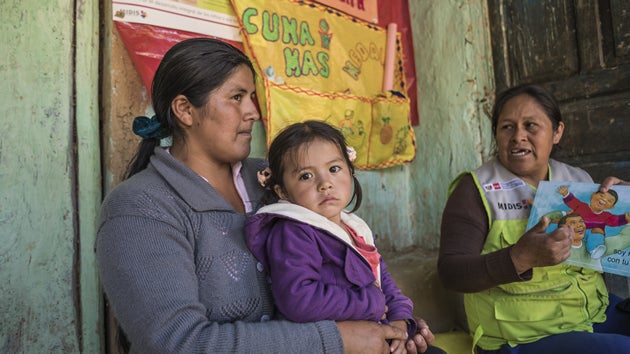How was the Juntos conditional cash transfer program implemented at the local level? Often times, national programs that appear to be well designed can falter when they must adapt to realities on the ground. For policymakers, it is imperative to consider and plan for local level implementation. The experience of Juntos illustrates what it takes for a large-scale conditional cash transfer program to be applied at the district level, and how local authorities can sometimes adapt programs based on their own contexts and policy objectives.
Background
The Juntos conditional cash transfer programs initially targeted rural, mostly indigenous communities that were historically excluded from government health services. It specifically focused on the Andes and Amazon states, where geographic isolation made it difficult to access services and raise families. For these families, Juntos provides “ayudita” - a little help - a material incentive to help overcome geographic barriers to accessing healthcare. Traveling several hours to reach a health clinic is more bearable when there is financial compensation for the time required.

Monitoring and evaluation
Juntos requires that households fulfill the following conditions in return for a PER 200 (approximately $60) payment every other month:
Register children under the national identification system and obtain identification documents
85 percent school attendance
Completion of CRED growth monitoring check ups
Attendance at pre- and post-natal exams for pregnant women and new mothers
Local Juntos managers monitor fulfillment of these conditions by filling out huge forms, referred to as “bedsheets” because of their enormous size, during month-long trips across their districts. Sometimes, managers visit health facilities, review paper files to check on compliance, and fill in mothers’ and children’s health histories; other times, managers announce their presence in a village and request that mothers produce their own health records to prove compliance with the program requirements.
Upon completion of the bedsheets, Juntos managers return to the regional office and input the records, which include maternal and child health indicators and information on other interventions in addition to the Juntos conditions, into an online system over the course of three days. Each manager is responsible for certifying the compliance of a large number of households (1,500 on average in Cajamarca).
Health care workers
Accurate reporting through Juntos bedsheets requires meticulous recordkeeping by health care workers in rural facilities. This is not always easy - Juntos has increased demand for health services while simultaneously significantly increasing administrative burden.
As a result, the completeness of Juntos recordkeeping varies from region to region. In 2012, 88 percent of health establishments in Cusco completed their paperwork; not a single facility in Cajamarca filled out the necessary forms. Neither region had enough health workers per capita to meet the WHO recommendation of 23 doctors, nurses, and midwives per 10,000 population (Cusco had 17.4 health workers per 10,000 population; Cajamarca had 14.2).
In many cases, it has taken time for the supply of healthcare workers to catch up to the new demand for care and new responsibilities. In addition, it can remain a challenge to recruit and keep skilled health workers in rural Peru, with its poor conditions and frequent stock outs. This staffing shortage means that Juntos beneficiaries sometimes fill labor gaps. In the past, women beneficiaries themselves have helped to ease the burden on health workers and administrative staff by filling out forms and delivering paperwork to clinics and schools to prove their compliance with the program’s requirements. In some places, they have been integral to the functioning of the program.

Shadow conditions and fidelity of implementation
While Juntos has had a consistent set of conditions required for cash transfer since its inception (with one adjustment: Peru extended the number of years of mandatory schooling in recent years), fidelity in program implementation across a large and diverse country was not always 100%. Instead, official conditions were sometimes mixed with unofficial “shadow” conditions.
Local Juntos managers sometimes imposed additional conditions on beneficiaries of the program. For example, health facilities seeking to improve their in-facility birth numbers might ask Juntos managers to speak with women about institutional delivery; Juntos managers might then add in-facility birth as an additional condition for cash transfer. Other unofficial conditions and complementary activities included use of clean cookstoves and oncsumption of leafy green vegetables. In this way, Juntos could often be implemented quite differently from one place to another. This was particularly the case before 2011, when Juntos came under tighter national control through MIDIS. Until 2011, it was managed somewhat autonomously at the local level - with many decisions made without knowledge of the national government in Lima.
